The origins of the steam engine
An essay with interactive animated diagrams
by Anton Howes and Matt Brown · November 29, 2023 · 11 min read
This is a guest post written by Anton Howes and animated by Matt Brown of Extraordinary Facility. This project was sponsored by The Roots of Progress, with funding generously provided by The Institute.
Steam power did not begin with the steam engine. Long before seventeenth-century scientists discovered the true nature of vacuums and atmospheric pressure, steam- and heat-using devices were being developed. Here we’ll explore the long, little-known story of how the steam engine evolved. And have fun playing with the ancient devices.
The Oldest Experiments
Steam engines exploit two forces. One is the pushing force of heating and expanding air and water vapour. The other is the suction effect of cooling and condensing them. Both principles were known at least as early as the 3rd Century BC, in an experiment described by Philo of Byzantium.
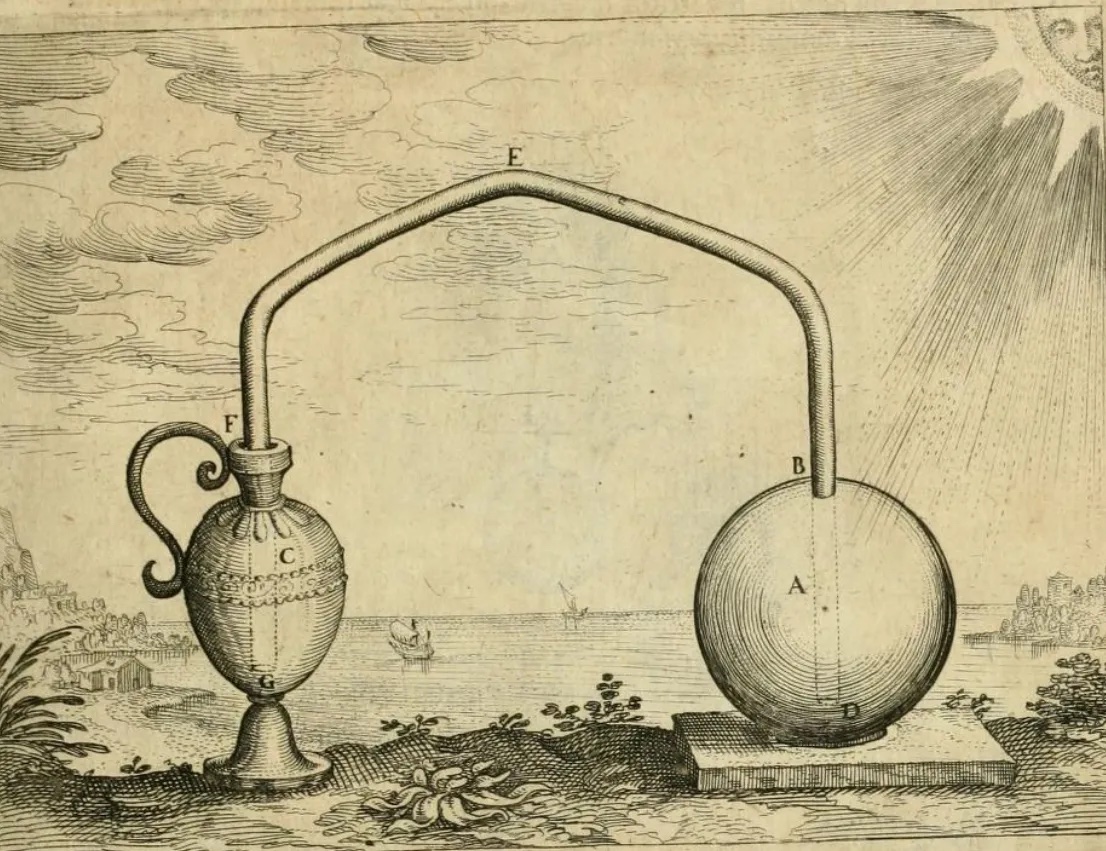
In Philo’s demonstration, heating the air trapped within a sealed container caused it to expand and push water up a tube into an open vessel. When the trapped air was cooled again, the water was sucked back into the container. Have a go. You can drag all the models to see them from different perspectives:
Seems straightforward and simple. But there’s a lot that can be done with it.
Earliest Applications
Hero of Alexandria in the 1st Century described how Philo’s principles could be used to make a solar-activated, self-replenishing “dripper” fountain.
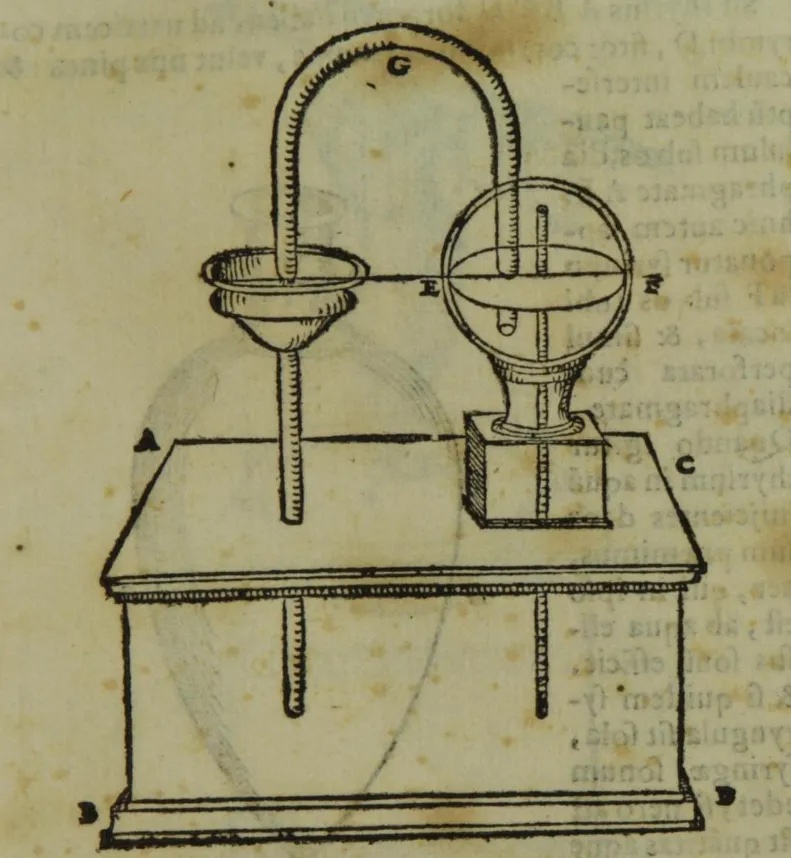
When the sun shone on the container, the air trapped inside it heated and expanded, pushing the water up the fountain’s spout to drip into a reservoir below. When the trapped air cooled again, the contraction sucked water back through a tube from the reservoir below, replenishing the device. Give it a try:
Hero also described how to apply the same principles to lift and move objects. The example he gave was of opening temple doors by setting a fire at an altar, which would close again when the fire was extinguished:
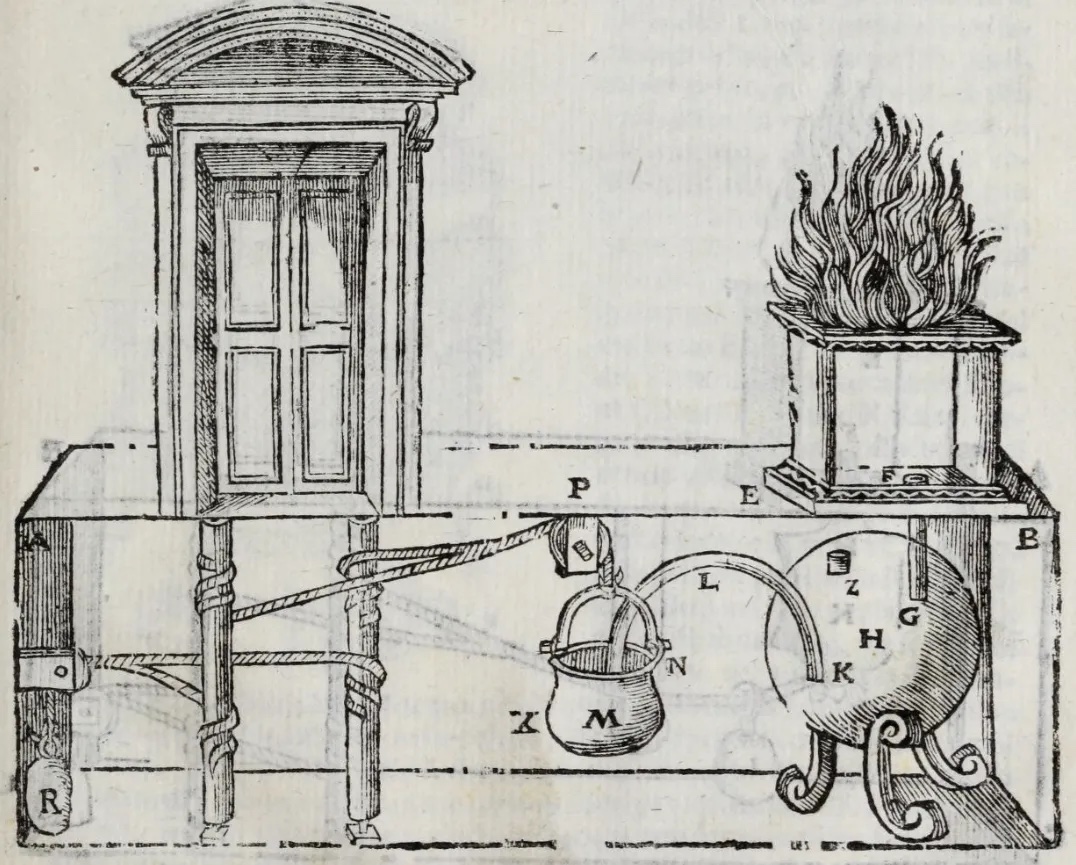
The air trapped within the altar, when heated by a fire, expanded and pushed water into a hanging bucket. The bucket, as it filled, pulled on a rope to open the temple doors. When the fire was extinguished, the contraction of the air in the altar drew the water back from the bucket, allowing the doors to be closed by a counterweight:
The knowledge of Philo’s and Hero’s devices were passed down in manuscripts over the course of the Middle Ages, and continued to be developed. Solar-activated fountains were used near Venice in the 1580s. And in 1615, the French engineer Salomon de Caus described using exactly the same principles to run an even more powerful solar-activated, self-replenishing fountain.
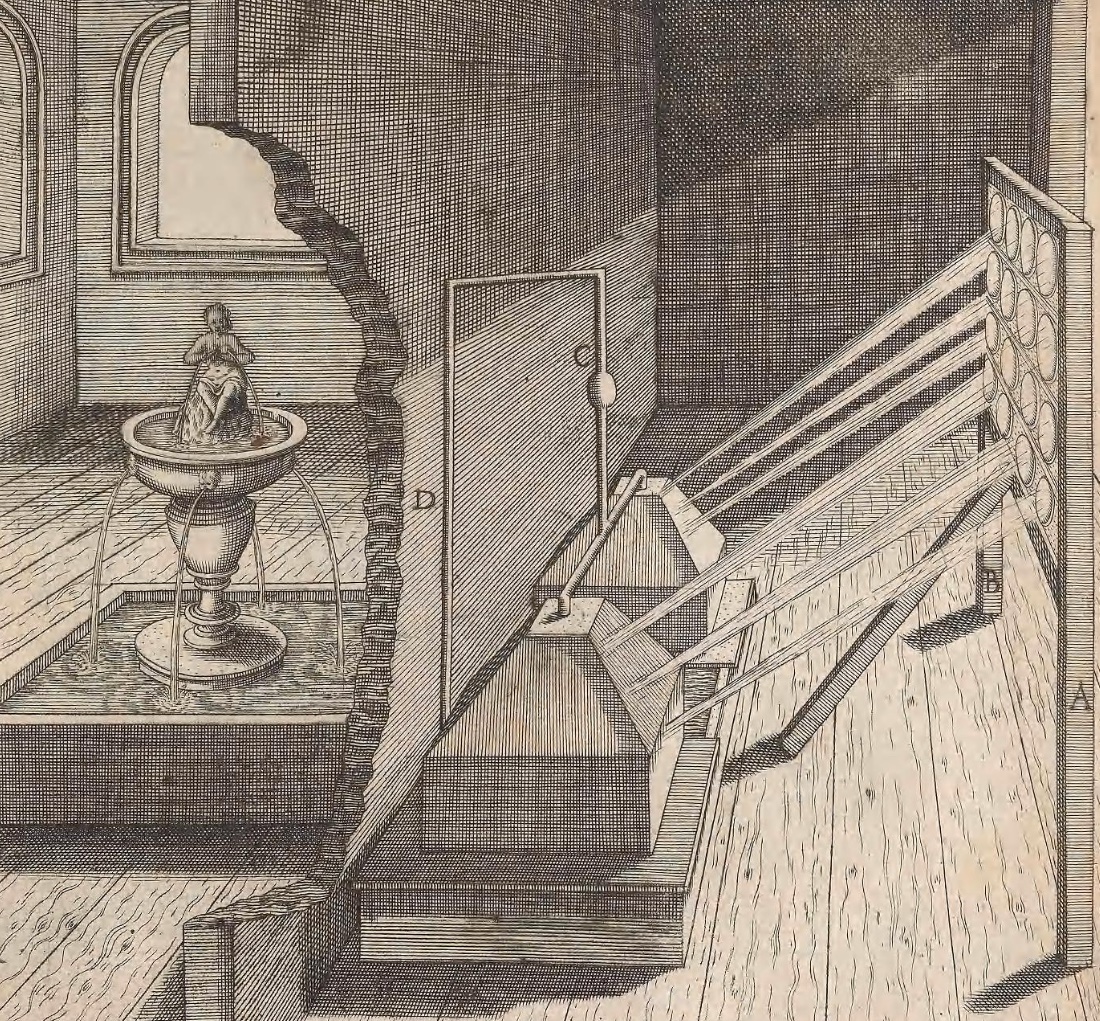
For this device, de Caus used lenses to concentrate the rays of the sun on the air trapped within a series of copper vessels, which together raised water for the fountain. Just like in Philo’s and Hero’s devices, the contraction of the air when it cooled again created a suction effect to refill the vessels from below.
De Caus used exactly the same principle to create noises! He had read about a statue of Memnon in ancient Roman-ruled Egypt, which was said to have made a noise at a particular time each day. De Caus believed this must have been done artificially, so set out to recreate it.
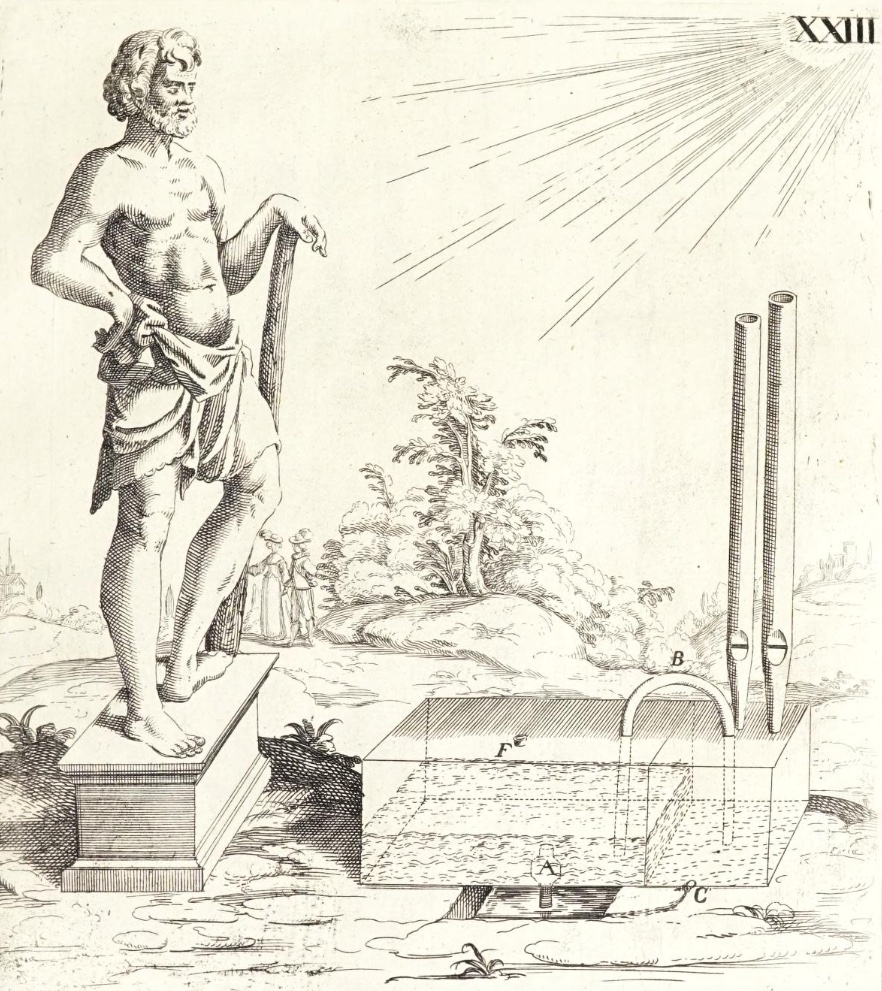
To create a noise when the sun shone, de Caus adapted Hero’s dripper fountain. When the sun shone upon the device and heated the trapped air, the fountain’s water pushed air through some musical pipes. When the trapped air cooled again, the instrument replenished itself with water from below.
De Caus then made further improvements. In 1644 his brother Isaac de Caus published a description of a machine that, at a specific time each day, would make more than just a short noise. It would play an entire tune.
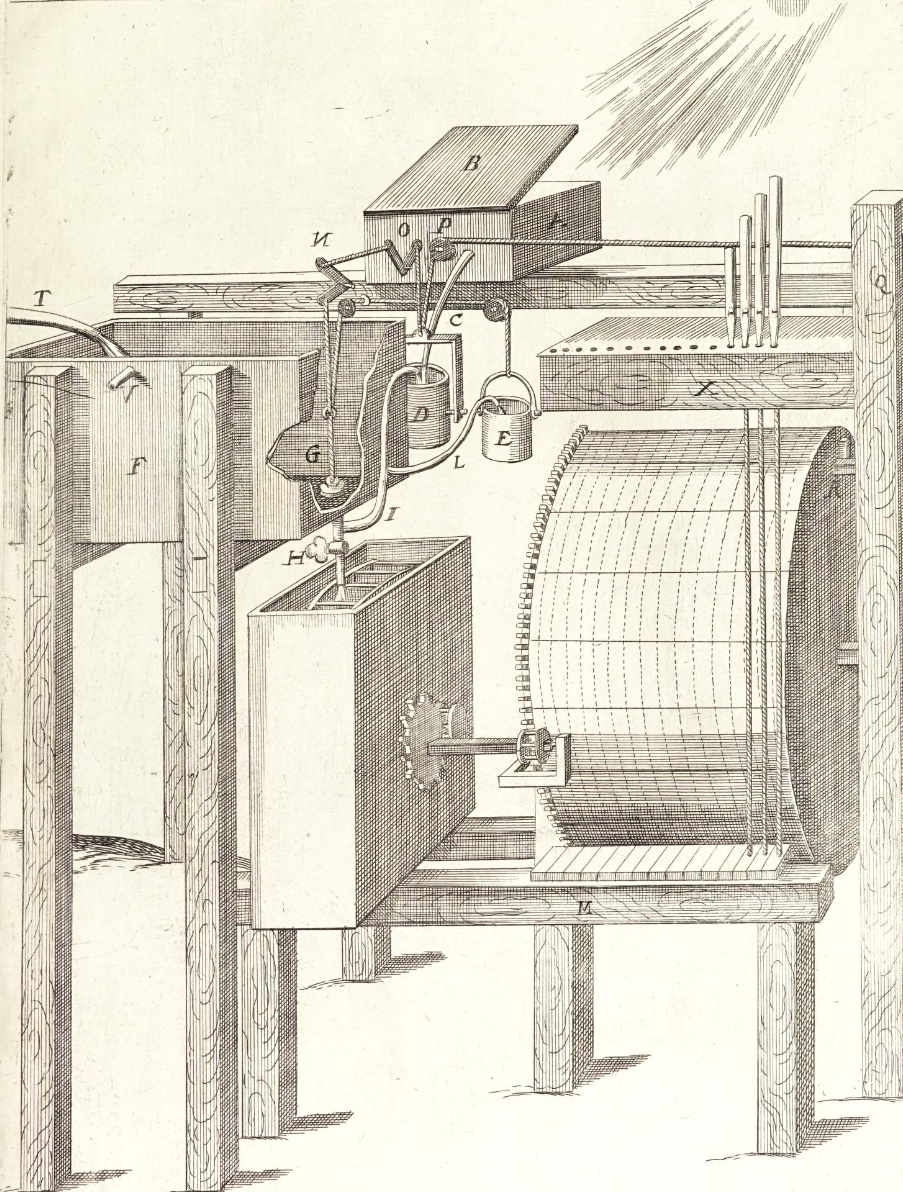
It worked much like Hero’s temple doors. At a set time each day the sun would expand the air trapped in a vessel, pushing water into a hanging bucket. The fall of the bucket released water over a wheel to power a self-playing organ. Have a go at activating it.
When overly full, the bucket would then tip up its contents to stop the tune. As the air in the vessel cooled, it drew up water for the following day. (This second phase is not shown in the diagram above.)
Scientists Become Interested
Philo’s ancient experiment also began to be investigated by scientists. Although it had been passed down in manuscripts for centuries, after 1558 it also began to appear in print. The bestselling work of the Neapolitan scientist Giovanni Battista della Porta helped to popularise a simplified version using glass.
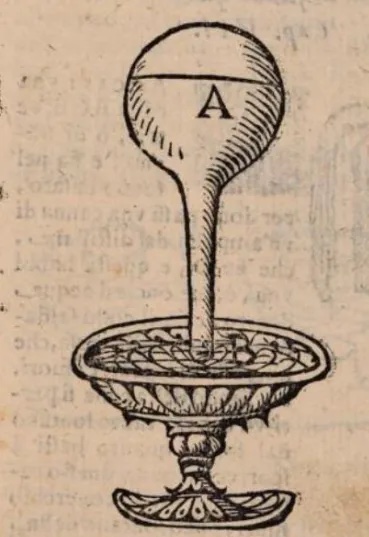
Della Porta described how an empty glass flask, when inverted and placed mouth first in water, could be used to raise that water – seemingly in defiance of nature. Heating the flask caused the air inside it to expand and bubble out. And as the rest of the trapped air cooled and contracted, the water would rise up into the flask. Have a go at adding the heat, and then take it away.
Della Porta called it natural magic.
By 1612 a professor of medicine at Padua, Santorio Santorio, noticed that the level of the water within the inverted flask would fall or rise according to the heat’s or cold’s intensity. By measuring the distance by which it rose or fell, and marking it with a scale, he used it as a device to measure temperature. Santorio reinterpreted the ancient demonstration to invent the thermometer.
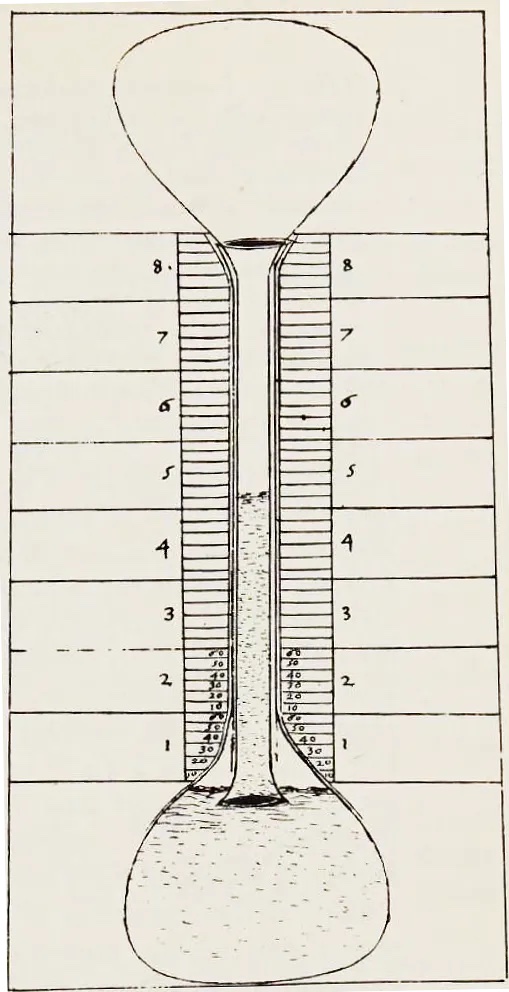
But Santorio’s device was not a perfect thermometer. The level of the water in the inverted flask did not just respond to the changing temperature of the air trapped within it. It also responded to the pressure of the air outside it. A curved version of the same device began to appear in northern Europe in the 1610s, known in the Netherlands as the donderglas (thunder-glass), and in England as the weather-glass or kalender-glass.
This alternative version of Santorio’s device, almost certainly invented by the Dutch inventor Cornelis Drebbel, was instead used as a kind of barometer, to signal impending storms. As the atmosphere got lighter and lighter, it pressed less and less upon the surface of the water within the curved flask, causing it to rise out of it. Drag the slider to change the weather:
(By the way: It was only later that the interfering effects of barometric pressure were removed from Santorio’s thermometer. This was achieved in the 1640s, probably by Grand Duke Ferdinand II of Tuscany, by sealing off the end of the device so that it was no longer open to the atmosphere and would no longer be affected by it.)
Drebbel’s Wonders
As well as inventing the thunder-glass, Cornelis Drebbel found more ways to exploit the periodic rising and falling of water in response to changes in temperature and atmospheric pressure – what he thought of as a way to harness the perpetual motion of the universe. His colleague at the royal court in England, Salomon de Caus, helpfully illustrated how Drebbel could do this:
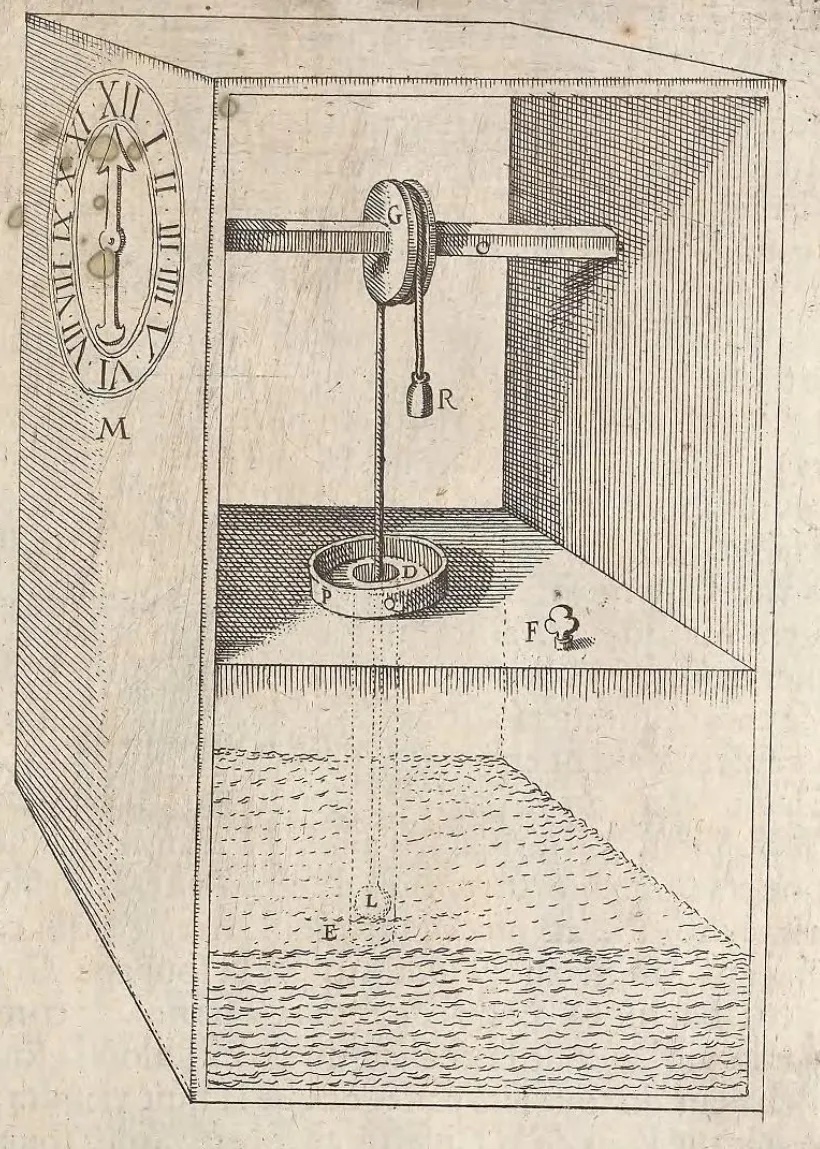
This is effectively just another version of the inverted flask experiment, but with the thin tube being the part open to the atmosphere instead. For simplicity’s sake, we’ll show only the effects of temperature on the device, without the complicating effects of atmospheric pressure. As the trapped air is heated, it pushes water up the tube, upon which floats a weight. The changing level of the water, by raising or lowering the weight, can turn an indicator dial. Drag the slider to change the temperature and move the dial.
Drebbel took this concept to an impressive extreme. In 1598 he obtained a Dutch patent for a perpetual clock, and wrote to king James I of England offering to build him a perpetually moving model of the entire cosmos. Drebbel’s “perpetual motion”, kept at Eltham Palace from around 1606, became the wonder of all Europe. Its dial showed the time, day, months, year, and zodiac. A small sphere on top indicated the phase of the moon. And the liquid in a ring of glass around it appeared to move up and down with the tides:
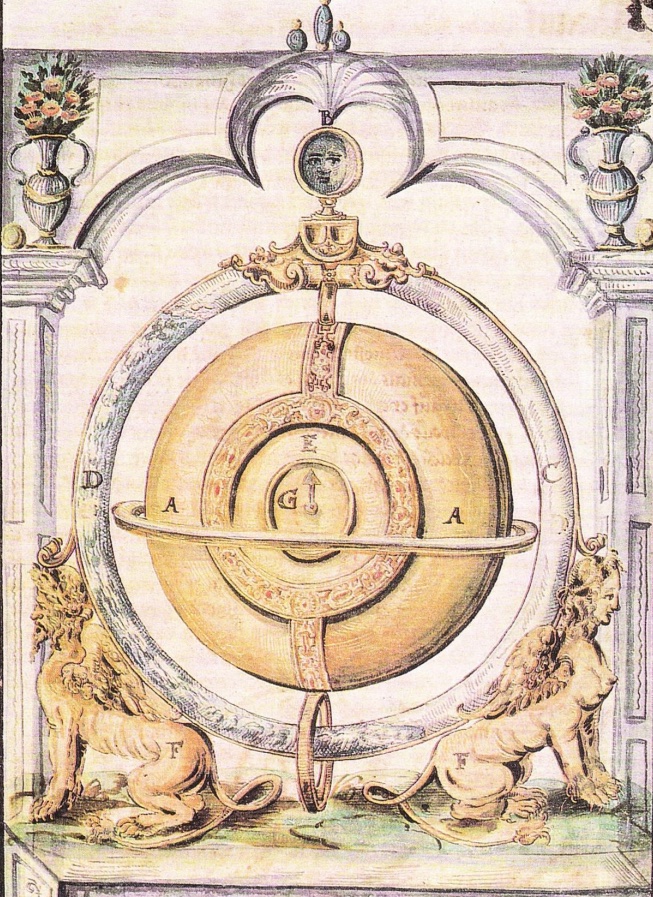
Drebbel’s “perpetual motion” harnessed natural changes to both temperature and atmospheric pressure. For simplicity’s sake, here is how it responded to just the heat of the sun. The “tide water” shown in the outer ring was really moved up and down by the heating and cooling of air trapped on one side. Now drag the model to take a look at the back.
Another pocket of trapped air, when heated, pushed on a liquid that was probably mercury. This periodically re-wound a spring-driven mechanism that powered the dial and moon indicator, keeping it all going “perpetually”. We don’t know for sure how it worked, but this is our best guess.
Steam Gets Serious
In the late 1630s, at Vauxhall near London, the German or Danish gunmaker Kaspar Kalthoff attempted to apply the same water-raising properties on a much larger scale, as did the English writer William Petty in 1649. Unfortunately, the full details of Kalthoff’s and Petty’s inventions have not yet been discovered. But the French mathematics teacher and Jesuit priest Jean François published a description of a seemingly identical device just a few years later in 1653.
Water was boiled into steam, which then filled a raised vessel. The steam replaced the air already in the vessel, which was pushed out via a vent. When the vent was sealed, the cooling and condensing of the steam in the vessel sucked water up from a reservoir below it. Once raised, the water could then be released by a tap, with the air vent opened up again to allow the water to fall out. Try raising the water and then releasing it:
François suggested using this device to raise water for kitchens, and as late as the 1790s an improved version of it was being used in England to raise water to drive industrial waterwheels.
But both Kalthoff and Petty envisaged even heavier-duty applications, like pumping the water out of flooded mines. The problem, as they both discovered, was that there was a physical limit to how high suction can raise water. Beyond a height of about 34 feet or 10 metres, it simply ceased to work.
The Limits of Suction
This same limit had been noticed in 1630 by Giovanni Battista Baliani, who could not get a large copper siphon to work. Below 34 feet, when he released both ends of the siphon the water would flow from the higher level to the lower level until they were both the same. Higher than this, however, the water would break within the siphon, rushing out of both ends to a level of no more than 34 feet above the surface of the water at either end. Drag the slider to see the action of the water. Now try switching to a higher siphon, and see Baliani’s problem:
Baliani wrote to the scientist Galileo Galilei to ask how this could possibly be the case. The siphon was made of solid copper, and no air seemed to get in, so he could not work out how there could be a gap left above the water in the siphon. An absence of anything there – a vacuum – was widely believed to be impossible. Galileo’s answer was that the column of water within the siphon was like a physical rope, and that above a certain height it would no longer be able to support its own weight and thus snapped. He argued that the space left above the columns of water must indeed be a vacuum. Shocking!
In 1643 Gasparo Berti tested Galileo’s theory with a single lead pipe of water over 34 feet high, with a glass sealed to the top. This enabled him to see through the glass that there really was a gap above the column of water. And in 1644, Evangelista Torricelli and Vincenzo Viviani repeated the experiment in miniature with a much denser liquid, mercury. They discovered that no matter the size of the space left above the column of liquid, it would always fall to the same height. Drag the slider to open the bottom of the pipes. See how the mercury falls to the same level regardless of the space above:
Instead of suction being caused by a liquid being pulled up, to prevent an “impossible” vacuum being formed, Torricelli reasoned that suction was actually the result of the atmosphere pushing a column of liquid into an empty space. The atmosphere could only raise the liquid as high as its weight would allow, until their weights balanced out. Torricelli reasoned that “we live submerged at the bottom of an ocean of elementary air”.
It was then also noticed that the level of the liquid within the experiment would rise and fall according to changes in atmospheric pressure, but without the interfering effects of changing temperature. Unlike Drebbel’s weather-glass, Torricelli’s experiment had no trapped air that would expand or contract as it was heated or cooled. So he had also discovered the barometer.
The Expansive Force of Steam
Although the suction effect from cooling and condensing steam was limited to 34 feet, much more could be done with the opposite, expansive, pushing force. Many of the devices we have looked at exploited the expansive force of heated air, perhaps with some water vapour involved, but there were also many older devices that exploited the much greater force of hot steam.
Steam could be boiled and forcefully directed through a narrow spout – a device often known as a “philosophical bellows” or an aeolipile, after the Greek wind god Aeolus. Aeolipiles were often used by alchemists to produce a blowtorch effect, and could also be directed at turbines, as suggested by Leonardo da Vinci in the fifteenth century, by the Ottoman scientist Taqi ad-Din in 1551, and by Giovanni Branca in 1629.
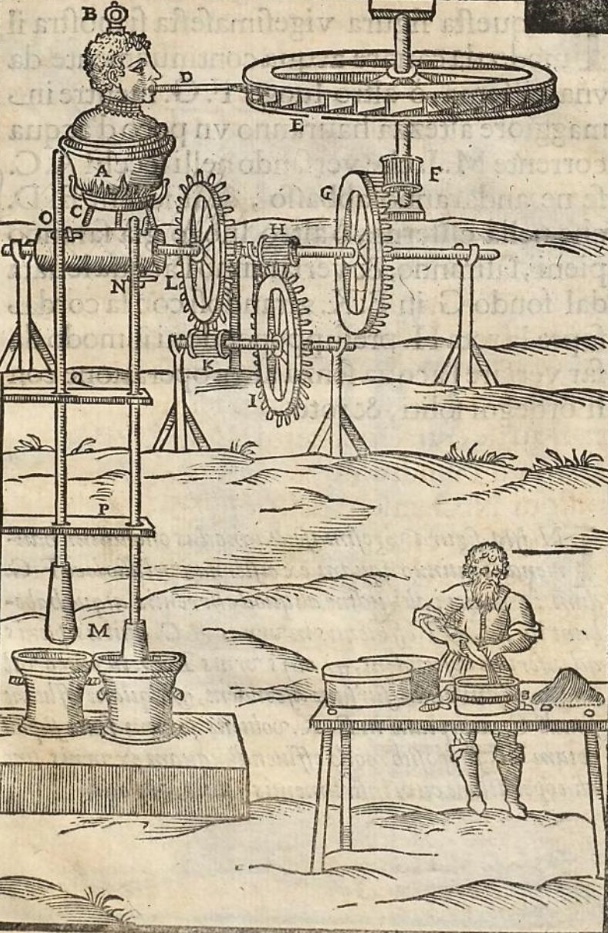
The aeolipile dated back at least as early as the first century, however. Hero of Alexandria described a few different version of the device, the most famous of which involved passing the steam from the boiler into a hollow sphere, which then spun on an axis:
Many of these devices would not have been able to achieve much more than very light mechanical work. But by 1606 the Spanish military engineer Jerónimo de Ayanz y Beaumont had invented a way to exploit the expansive force of steam to pump water out of mines. A similar, if not identical, engine was being developed by Kaspar Kalthoff in the 1640s, and by Edward Somerset, the second Marquess of Worcester, by the late 1650s (seemingly with Kalthoff’s help).
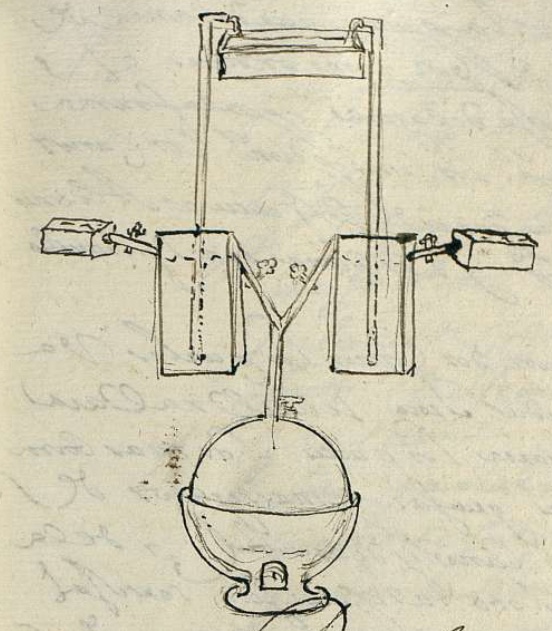
De Ayanz’s engine worked by admitting mine water to one of two vessels, using hot steam from a boiler to push the water in one vessel higher up while the other refilled through gravity. By alternating vessels, it could pump the mine water up continuously. But it did not exploit the cooling of the steam. Drag the slider to the right to see the machine go through a single cycle.
The Steam Engine Arrives
In 1698, the English inventor Thomas Savery patented an engine that combined the effects of both expanding and condensing steam. His was the first engine to be widely used, though Kalthoff may have begun similar experiments in the 1640s, and a very similar device using air instead of steam had been sketched out in 1622 by the Dutch scientist Isaac Beeckman. Savery submitted a detailed description of his engine to the Royal Society, and in 1702 published a detailed description of it. He dubbed it “the miner’s friend”.
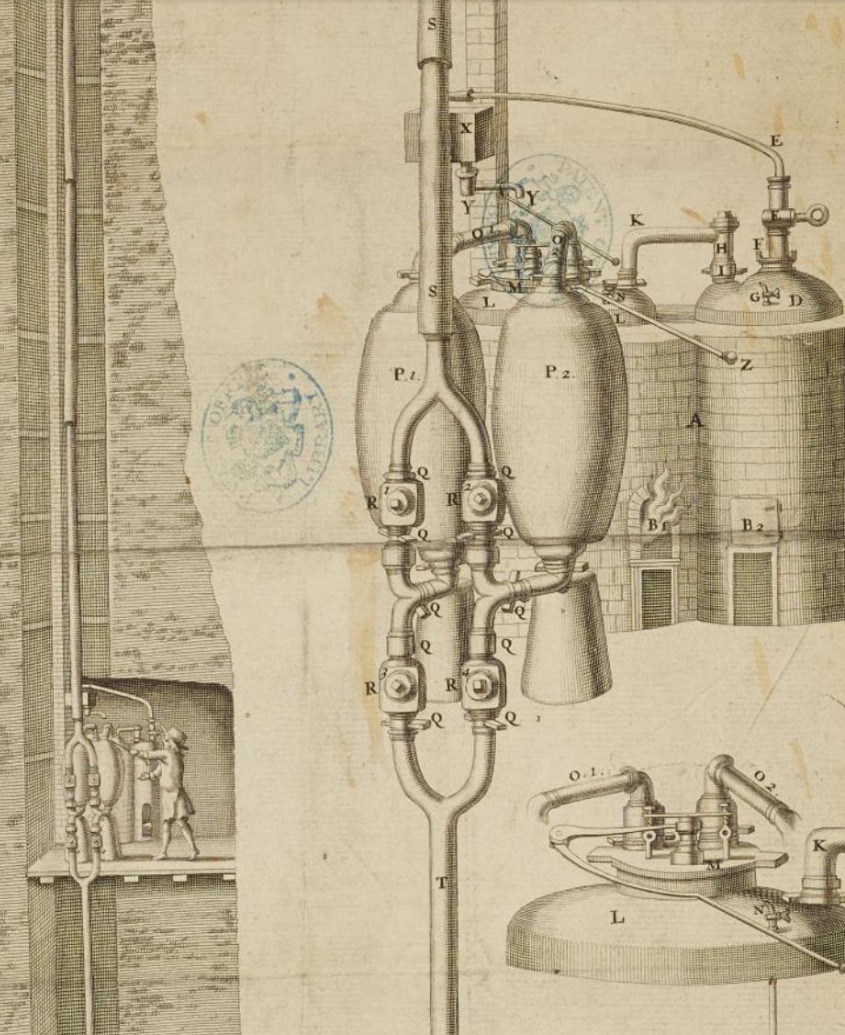
Water was boiled into steam, which then filled a vessel. Cold water was poured over the vessel so that the steam inside it condensed, sucking water up into the vessel from the mine below. Then the hot steam was readmitted to the vessel to push the water even higher. While hot steam pushed the water up in one vessel, the other vessel sucked water up through condensation, and vice versa, alternating so that the machine pumped the water continuously. Drag the slider to the right to see it go through one full cycle. And as always, remember you can drag the model to see it from different angles.
Over the course of the eighteenth century, Savery’s engine was used for raising water for domestic use, in gardens, and for driving waterwheels that powered factories. But despite being called the miner’s friend, it was probably never used to drain mines. That task was instead given to another kind of steam engine, but that’s a story for another time.
If you like this format, and would like to sponsor us to create more, get in touch: jason@rootsofprogress.org.
Comment: Progress Forum, LessWrong, Reddit
